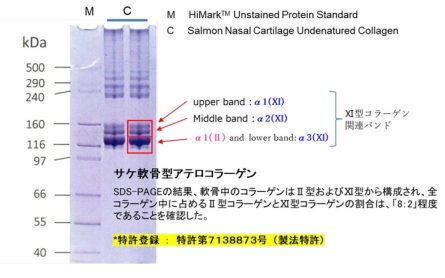New specification of SCP Complex-LS
Undenatured Proteoglycan
Linise Ltd. and Anti-Aging Pro corporation, we decided to change the specification of SCP Complex-LS as follows on March 01, 2023.
Download: The latest specification revised on March 01, 2023
The undenatured proteoglycan of salmon cartilage has the crosslinked structure of 2-3 aggrecan of proteoglycan. The crosslinked structure is cut in GPC column for HPLC analysis on the HPLC analysis process. So we could not show the real molecular weight of undenatured proteoglycan until now. On the other hand, we could show the real molecular weight (2,000 to 4,150 kDa) by HPLC with Multi Angle Light Scattering this time. With this new knowledge, we changed the specification.
Undenatured Collagens
 Also we have discovered another new knowledge in relation to undenatured collagen of salmon cartilage. As results of research and development with Fukui Prefectural University, we succeeded in separating type II collagen and type XI collagen on the electrophoresis (right figure, in Japanese) and discovered that salmon cartilage has type XI collagen with type II collagen.
Also we have discovered another new knowledge in relation to undenatured collagen of salmon cartilage. As results of research and development with Fukui Prefectural University, we succeeded in separating type II collagen and type XI collagen on the electrophoresis (right figure, in Japanese) and discovered that salmon cartilage has type XI collagen with type II collagen.
And the study of new knowledge was submitted by Professor Mizuta (Fukui Prefectural University) and be published on Fisheries Science in April, 2023. With the publishing of study, we change the specification as follows in 2024.
We change the specification, but the essence of material is the same with the existing material. And we don’t change the manufacturing method/process and the source.
Attentions on analysis
On the old analytical method by automatic amino acid analyzer, the result includes all collagens (e.g. type I collagen, collagen peptides, gelatin and so on). This method was not perfect.
And the date shows zero/non in the case of Elisa method used undenatured type II collagens of other source (e.g. chicken, human, bovine and so on) as the standard. Because the antibody will not react if the source is different. In addition, Elisa method is not suitable for the analysis of undenatured collagens extracted from salmon nasal cartilage. Because salmon nasal cartilage has both of type II collagen and type XI collagen and its collagens cannot be separated while maintaining their denatured shape.
Therefore, we developed new analytical method (Mizuta et al, 2023) by the polyacrylamide electrophoresis with Professor Mizuta of Fukui Prefectural University. On the method, the polyacrylamide electrophoresis was used for the separation of collagen chains. And the content was calculated from these color strengths of each band.
We disclose the details of new analytical methods after contracting NDA.
Basically, the quantitative analysis of undenatured collagens sourced from salmon nasal cartilage would be impossible without our supports, the standard reagent and detail information of new analytical methods.
*The automatic amino acid analysis is useful for quantitative analysis of raw materials if the qualitative analysis shows that all collagens are denatured collagens. Collagen contents in SCP Complex-LS (SCP-II) have confirmed the identify between automatic amino acid analysis method and polyacrylamide electrophoresis method.



